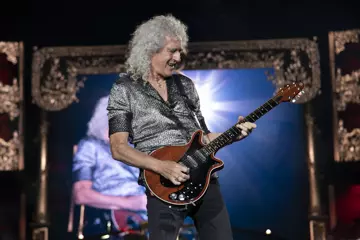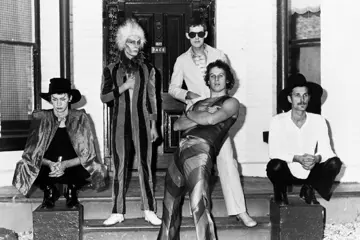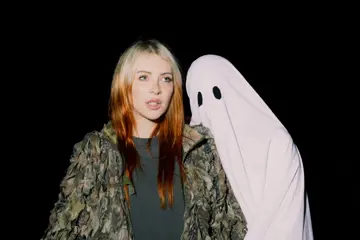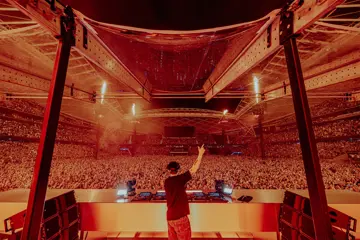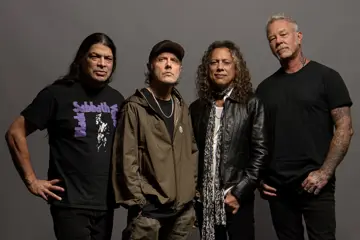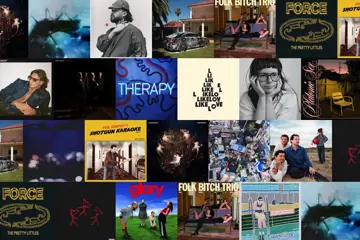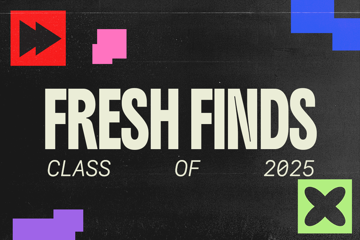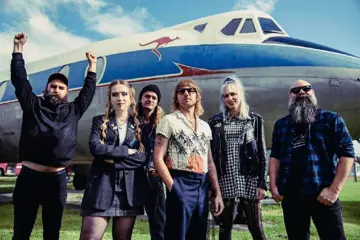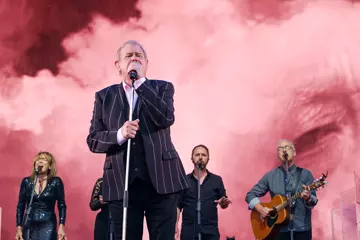THE ACCOUNTANT

“He's an accountant!” yells villainous John Lithgow, at some point of The Accountant, filled with disdain that an armada of military-trained hitmen can't seem to take out one mere pencil-pusher. But Gavin O'Connor’s artful action-movie riff is, at the very least, out to subvert the archetypes evoked by CPAs.
"One man, forever on the run, able to elude assassination and escape the law, stopping only to prepare tax returns for mom & pop farms."
Here, the accountant in question is played by Ben Affleck, and penned by screenwriter Bill Dubuque as the world's most interesting man. For starters, he’s no regular nerd with a calculator, but an Asperger’s-rollin’ mathematical genius, his Beautiful Mind humming with numbers, which he mumbles to himself whilst scrawling complex equations all over the glass walls of offices. And, on top of that, he's also a remorseless killing machine, firing guns from long range and breaking faces from close; trained from birth to kick ass, his flashback-illuminated youth filled with brutal Pencak Silat lessons in Indonesia, beating down bullies in Parisian ghettoes, feeling the fists of his abusive pops, and forever testing himself against his killing-skilled brother.
So, in short, here Affleck is like Matt Damon in Good Will Hunting crossed with Matt Damon in the Bourne movies: one man, forever on the run, able to elude assassination and escape the law, stopping only to prepare tax returns for mom & pop farms and audit the books of billion-dollar robotics concerns. It’s the latter that leads him to crossing paths with Lithgow, and ending up in one of those action-movie scenarios where our ‘hero’ has to shoot innumerable people and break many faces and dodge certain death and rescue the girl (Anna Kendrick!) and earn the begrudging respect of the grizzled, nearing-retirement cop (J.K. Simmons!) on his trail.
Don't miss a beat with our FREE daily newsletter
All of these action-movie moves are impossibly generic, and the novelty of the lead character — He's not a hitman, he just does the books for the mob! He's an action-hero, but he’s on the spectrum! — grows increasingly ridiculous with every flashback, every revelation, every skeleton from the family closet. The whole thing is, when approached with any kind of critical thought, pretty idiotic. It’s a dumb film about a genius, but, it's smartly-made; The Accountant’s wry script, crisp direction, understated Affleckin’, and general top-shelf casting adding up to something worthy of two-hours time-killing.
MORGAN

Morgan is about a different, more literal kind of unstoppable-killing-machine: lady robots! It begins as a kind of corporate procedural: cold, calculating ‘risk assessment’ operative Kate Mara arriving at the gothic Pacific Northwest mansion where a crew of scientists (Michelle Yeoh, Toby Jones, Jennifer Jason Leigh, Rose Leslie, Vinette Robinson, Chris ‘Cleary from The motherfucking Knick’ Sullivan) has been raising an android (The Witch’s Anya Taylor-Joy), trying to balance her unstoppable-killing-machine programming with a more emotional, moral sense of the world. Given she’s just stabbed Leigh through the eye in a pique of rage, the lessons aren’t quite taking; Mara here to find out if the whole project needs shutting down, bringing guns in case the ‘asset’ needs liquidating.
"The clan of scientists, who regard the titular character as a miracle of creation, the daughter they’ve never had, will overlook and excuse her murderous nature."
Seth Owen’s script balances its thematic ideas with the kind of heavy foreshadowing of a genre movie. In their isolated compound, the doctors and the android have become a veritable family: when Jones shows ‘observation’ videos of the subject, they’re like sun-kissed home-movies, all birthday parties and games in the garden. Morgan is, in some fashion, about emotional attachment and behavioural apologism; the way a person’s love for someone can blind them to their faults, make them forgive their transgressions. In this case, this means the clan of scientists, who regard the titular character as a miracle of creation, the daughter they’ve never had, will overlook and excuse her murderous nature, even after getting stabbed in the eye.
Whilst a more thoughtful film — something in line with Ex Machina, the film Morgan will forever be compared to — could make dramatic hay from these themes, director Luke Scott (Ridley Scott’s son, nepotism fans) can only push them towards genre clichés. So, just as the scientists resemble a family, they also resemble the crew of, oh, say, a space-ship, soon to be picked off, one by one, by an alien in their midst. This means that, eventually, inevitably, Morgan must head towards a showdown between Mara and Taylor-Joy, unstoppable-killing-machines in their own right, set against each other. People are shot, fistfights are had, car-chases are staged, and they battle to the death. Come the third act, there’s no contemplation of the interactions between human and AI, just a lot of generic nonsense.
HACKSAW RIDGE
Hollywood is littered with Australians talkin’ in American accents, and, with Hacksaw Ridge, Mel Gibson brings ’em all home. Sure, his sentimental war-movie matinée stars Andrew Garfield, who’s long been an Englishman talkin’ in an American accent; and there's even an actual American, Vince Vaughn, brought in to do a cut-rate Full Metal general routine as insult-slinging army dick. But, elsewhere, witness generations of Australian screen talent — Robert Morgan, Hugo Weaving, Rachel Griffiths, Richard Roxburgh, Sam Worthington, Ryan Corr, Luke Bracey, Teresa Palmer — filling a cast involving not a single Australian character.
Ol’ Sugartits’ first directorial effort in a decade is billed as an ‘anti-war’ war-movie, given that Garfield plays the real-life 7th Day Adventist pacifist whose devotion to Godly non-violence lead to him serving as a medic in the U.S. Army in WW2, yet refusing to carry a rifle whilst he did. This earns the ire of military men — fighting for a nation defined by its love of weapons — and finds him accused of cowardice, mocked for his lack of masculinity. Eventually, our hero is proven right — “I’ve never been more wrong about someone” once-antagonists apologise — when he acts with astonishing valour on the field of battle; single-handedly saving the lives of countless wounded via bravery, faith, and foolishness. It’s a super-stirring, patriotic film whose based-on-a-true-story tale gets its own Sully-styled mini-doc in the credits. And, despite its billing, it’s totally a war-movie.
Gibson struggles in much of the early going: the scenes of early childhood trauma and later tortured flashback are embarrassingly overwrought; the romance with Palmer can’t rise above the perfunctory; and the military-training sequences are the stuff of military-training cliché. But once Hacksaw Ridge is in the heat of battle, the tumult of confusion, then Gibson feels at home. It’s a parade of brutal, unheroised deaths, in which shrapnel tears through flesh, bullets fell mighty men, and limbs are blown clean off; the Japanese foes reduced to menacing figures on the horizon, we invited to identify with the characters we know. The horrors of war are duly horrifying — rats gnawing off human faces, men burned to death by flamethrower — which makes the eventual heroism all the more heroic.
THE LIGHT BETWEEN OCEANS

In the middle of its grim portrait of a resentment-riddled marriage and its method-actors gunning for awards-show plaudits, Derek Cianfrance’s breakout 2010 film, Blue Valentine, showed he had an uncommon knack for filming children; allowing the natural presence of toddlers to shine as his key cast interacted with them in improvised fashion. With his latest film, The Light Between Oceans, Cianfrance takes this further: this film defined by the presence of tiny Florence Clery, who plays the five-year old child at the centre of its stormy melodrama.
Michael Fassbender and Alicia Vikander play newlyweds living on an isolated island of the Southern tip of Western Australia, tending to the lighthouse in the wake of World War I. When a lifeboat with a dead man and a crying infant washes up on shore, they decide to keep the child and pass it off as their own. Eventually, they encounter the grieving widow and birth mother, Rachel Weisz, and are left to grapple with the shame, guilt, and moral weight of what they’ve done.
Based on a novel by M.L. Stedman, it’s essentially an exploration of motherhood and care; nature and nurture tangled up in a soap-operatic device that Cianfrance treats with unexpected seriousness and dread. His most evocative scenes come in the moments of montaged vérité where child and parents inhabit their environment; Vikander’s Country Road wardrobe aglow with maternal affection, Clery playing in rockpools and at tea-parties, drawing and cooking and celebrating her dad’s birthday. Again, rather than coaching up a child to deliver lines, Cianfrance has the actors play off Clery’s natural spirit; creating a sense of humanity, and capturing the kind of exchanges — and the fostering of profound love — familiar to parents everywhere.
When Clery is, eventually, caught in a dispute between duelling mothers, her furious emotions — raw, real, unguarded — give a shock of life to the film, play as so savage they singlehandedly redraw the parameters of what this film can be. The drama doubles down on what it sees as the greatest of tragedies — a mother separated from her daughter — with Weisz first losing an infant, and, later, Vikander losing the same daughter. But their grown-up handwringing is nothing compared to the defiant screams of an aggrieved child; and Fassbender’s macho martyrdom even seems less etched in pain.
In lesser hands, The Light Between Oceans would be a pat, windswept matinée for the blue-rinse set, a non-threatening parade of wartime tragedy and pretty scenery. But, here, amidst the grandstanding drama, Cianfrance finds moments of truth, and mines them for all they’re worth.
SOUTHSIDE WITH YOU

In many ways, Southside With You is an effective, effecting boy-meets-girl movie; a Before Sunrise-styled, 84-minute walk-and-talk tale. Here, a first date between a pair of budding lawyers becomes an examination of their social conscience, their hopes and dreams, their doubts and disappointments; these newfound paramours provoking responses, challenging each other on the stories they tell themselves. Set, in 1989, on Chicago’s impoverished Southside, there’s an engagement with real socio-economic issues, with Spike Lee’s Do The Right Thing evoked as a touchstone for the resentment building in Black America. It’s a film that has a sense of social optimism stitched into its romance: director Richard Tanne’s script believing that our lovers and families can inspire us to be better people.
That’s all great, except, the first date in question is a dramatised retelling of the meeting between Barack and Michelle Obama. That, unfortunately, lends Southside With You a winking quality that undermines much of its thoughtful thematic approach. Every time Tika Sumpter, playing Michelle, asserts that this isn’t a date, the audience is invited to warmly condescend to her; we knowing where things end up, and that the lady doth protest too much. Tanne can’t help but cast his dialogue in a retroactive light; his characters conversationally projecting dreams that will invariably come to pass. At times, it can feel like a writing exercise taken a step too far; but, as exercise, Southside With You does work, and sometimes, even, work well.
AMERICAN HONEY

In American Honey, Sasha Lane rescues a drowning bee from a swimming pool, a moth throwing itself against curtains, and a wasp trapped against a window. The film ends with her — having come out of her own shell, coming-of-age-movie style — letting a turtle go into a lake, fireflies hovering in the night air. Director Andrea Arnold fills her film with symbolic insects — ants in the kitchen symbolise squalor; moths frying on fluorescent bulbs self-destruction; two butterflies mating imminent congress — but in the moments that Lane saves creatures smaller than her, we see something close to American Honey’s dramatic theme, and its own raison d’être: how the poor and unfortunate can be rescued by a hand from above.
"American Honey’s cast is filled with all manner of non-professional actors, hardscrabble kids themselves drawn into the travelling circus of the film’s production."
Lane plays an 18-year-old girl escaping poverty and parental neglect, throwing her lot in with a travelling crew of hard-partying, down-and-out kids who, in between living a kind of constant Spring Break on the road, shill magazines as indentured slave-labour for bitchy bosswoman Riley Keough. American Honey’s cast is filled with all manner of non-professional actors, hardscrabble kids themselves drawn into the travelling circus of the film’s production. They’re brought together as a group, and the film is about group dynamics, from homoerotic hijinks to the shared rituals of bonding through listening to music.
The film tracks across Middle America, a landscape of highways, parking lots, strip malls, motels, and weeds. Arnold earnt a social-realist rep with 2006’s Red Road and her 2009 breakout Fish Tank, and she’s an observer of human behaviour and urban environs. With American Honey, she looks at the titular land with an outsider’s eye: the film filled with real locations, real people, real scenarios; its crew wandering from low-rent hoods to toffee suburbia, and eventually out to oil-country frontiers. As they go, they listen to an endless procession of hip-hop bangers preaching the pursuit of pussy and money, and their door-to-door sales are pure hustle, a dogged attempt to make some minor scratch in an unsympathetic country. When Lane finally lands a wad of sales from a crew of old cowboys, she yells “I feel like I’m fucking America!”
But, as much as it’s a portrait of America, the Nation as Business, the film is, at essence, the story of a first love. Early in the first act — as much as this 163-minute impressionist-portrait can be considered to have ‘acts’— she falls in thrall to Shia LaBeouf, who — in a turn bristling with life and daring — plays one of the outfit’s most charismatic salesmen. It’s a typical coming-of-age affair: personal exploration in the guise of growing obsession; its subject lost in the throes of passion, but coming out the other side with a greater sense of independence. The pair’s sexual attraction is all-consuming, possessive, self-destructive, tormented; when they get fresh, it’s a furious release, a place to escape.
This means that, in a strange way, American Honey has much in common with Arnold’s last film, 2011’s Wuthering Heights. In her radical adaptation of Emily Brontë, she stripped away the parlour-drama and set the primal passion against the wild weather of the wiley, windy moors; the young paramours tiny figures in a grand environment. With its constant shots of landscape — and, indeed, insects — American Honey does the same: its frisson of first love set against a greater canvas; all its lithe teen flesh and nihilist hedonism serving a greater socio-political picture.
NEON BULL

Neon Bull is a film about bodies, and carnality; set against the peddled horse-flesh and homoerotic pageantry of the Brazilian rodeo. In its two most eye-popping scenes, horse semen is collected by hand, and a cowboy and a heavily-pregnant woman fuck; the latter coming (so to speak) in one, unbroken five-minute shot, achieving a real frisson of raw screen intimacy. Perhaps paradoxically, this sex scene is shot not just statically, but from a distance. Director Gabriel Mascaro almost always shoots from afar, situating his figures in landscapes, be they man-made or natural.
Set in Brazil’s North-East, it’s full of dusty country; its drama centred around the ad-hoc family of the travelling rodeo crew. Mascaro cut his teeth making documentaries, and whilst his careful compositions — and the work of cinematographer Diego García, last seen lensing Apichatpong Weerasethakul’s Cemetery Of Splendour — are far from documentary’s reactive shooting approach, there’s a sense of that spirit at play in Neon Bull.
Mascaro approaches this world, of the rodeo, with a documentarian’s eye for detail; situating human drama in the middle of a subcultural ecosystem. Here, the climate is hot: the weather sweltering, the characters hot-blooded, and the bodies of bulls radiating heat. The film’s title comes from night rodeos, where the bulls are painted in glow-in-the-dark shades, their hides serving as a canvas for naked capitalist endeavour. Here, bodies are exploited, sold, traded, used; be they cattle or human.
THE AGE OF SHADOWS

With Park Chan-wook’s deliriously-fun The Handmaiden lighting up local screens, here’s another film from one of the iconic auteurs of Hallyu — Kim Jee-woon — set in Occupied Korea in the 1920s. The Age Of Shadows is a lavishly-appointed, big-budget thriller, with old Kim (and Park) leading men Song Kang-ho and Lee Byung-hun starring in a film whose initial title, Secret Agent, suggests its genre. But its new, more artful title is just as evocative: the era of Japanese occupation and local collaboration creating a climate of paranoia and distrust. Song plays a Korean turncoat working for the Japanese police, Lee the leader of the resistance, and there’s a vast, stellar cast filling in countless roles around them. It’s set in a shadowy realm in which everyone is double-dealing and double-crossing, where every supposedly-covert rendezvous is watched over by men peering from behind newspapers, and every car-ride is followed by a tailing car which is followed by another tailing car.
Kim has fun with this, especially in the great second-act movement in which most of the cast ends up on a train from Shanghai to Seoul. The locomotive is trussed out in meticulous period finery, but it works best as closed-room; creating a pressure-cooker where a convoluted web of exchanged glances suggests all the varied, shifting allegiances. The tension ratchets up until it, eventually, explodes in a hail of gunfire; something that’s repeated, again, when resistance fighters are moving through customs with false passports. When the gunfire breaks out, Kim is in his element: his camera hurtling and throttling, the editing dizzying and disorienting, a kinetic energy sweeping audiences up. The film, ultimately, becomes an earnest tribute to those dissidents who fought for independence.

